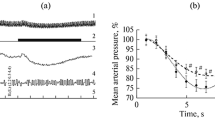Summary
-
1.
In order to compare the selective value of repetitive cathodal pulses of 8 c.p.s. and of continuous sine-wave alternating currents of 5000 c.p.s. (middle frequency current) when applied to brain tissue, explorations were made in the region of the hypothalamus that had yielded defence and/or flight reactions in earlier experiments. The region was explored by stimulating each point in turn with both current forms. At the same time measurement was made of the impedance of the brain tissue, and the effects produced by altering the time of rise of the middle frequency current on threshold of responses were also studied. The experiments were carried out on unanaesthetized, freely moving cats.
-
2.
Both stimulation types produced affective (“emotional”) responses. The patterns elicited by low frequency cathodal pulse stimulation were often associated with stimulus-bound phasic muscle activity, i.e., flapping of ears, and twitching of whiskers, or, rotation of the head. Such extraneous motor effects were rarely obtained when continuous middle frequency currents were applied, and were tonic in character when present.
-
3.
Mapping of reactive points revealed that the area producing defence or flight following middle frequency stimulation is smaller in size than the field delimited by means of repetitive cathodal pulse stimulation. These results strongly suggest that spread of current can be reduced by using middle frequency current stimulation. This apparently local (and hence highly selective) action is paralleled by a lower impedance of the brain tissue to the rapidly changing polarity of this current.
-
4.
The hissing (and/or growling) associated with the defence pattern showed adaptation to suddenly rising middle frequency currents of 30 secs duration. An increase in threshold of hissing occurred when the time of rise of the current was prolonged. Flight, in contrast, was obtained at the same critical intensity regardless of the time of rise of current.
-
5.
The nature of the stimulatory action of middle frequency current (examined in the peripheral nerve by Wyss) and the advantages presented by this new method of brain stimulation are briefly discussed.
Similar content being viewed by others
Literatur
Corti, U.A., F. Gassmann u. M. Weber: Unruhebestimmung bei Menschen und Tieren. Verh. Schweiz. Naturforsch. Ges., Pruntrut, 164–167 (1955).
—, R.W. Hunsperger u. O.A.M. Wyss: Registrierung der vertikalen Kraftkomponente der endogenen Körpererschütterung (Haltetonus). Reaktionstisch für Tierversuche. Pflügers Arch. ges. Physiol. 274, 95 (1961).
Fernandez de Molina, A., and R.W. Hunsperger: Central representation of affective reactions in forebrain and brainstem: Electrical stimulation of amygdala, stria terminalis, and adjacent structures. J. Physiol. (Lond.) 145, 251–269 (1959).
Gildemeister, M.: Untersuchungen über die Wirkung der Mittelfrequenzströme auf den Menschen. Pflügers Arch. ges. Physiol. 247, 366–404 (1944).
Hess, W.R.: Beiträge zur Physiologie des Hirnstammes. I. Die Methodik der lokalisierten Reizung und Ausschaltung subkortikaler Hirnabschnitte. Leipzig: Georg Thieme 1932.
Hill, A.V., B. Katz and D.Y. Solandt: Nerv excitation by alternating current. Proc. roy. Soc. B 121, 74–133 (1936).
Hunsperger, R. W.: Affektreaktionen auf elektrische Reizung im Hirnstamm der Katze. Helv. physiol. pharmacol. Acta 14, 70–92 (1956).
— Affektreaktionen auf Mittelfrequenz-Reizung (5000 Hz) im Hypothalamus der Katze. Helv. physiol. pharmacol. Acta 23, C 25-C 28 (1965).
-Postural tonus and cardiac activity during centrally elicited affective reactions in the cat. Proc. New York Acad. of Sci. (1969, im Druck).
Kumazawa, T.: Intracellular recording of electrical response of muscle fibre to transversely applied middle-frequency pulse stimulation. Experientia (Basel) 22, 393–397 (1966).
— Excitation of muscle fibre membrane by means of transversely applied middle-frequency current pulses. Helv. physiol. pharmacol. Acta 26, 257–269 (1968).
—, u. O.A.M. Wyss: Mittelfrequenz-Querreizung des Muskels mit intracellulärer Ableitung am Reizort. Helv. physiol. pharmacol. Acta 24, C 33-C 36 (1966).
Labes, R.: Nerv und Membrankernleiter. II. Die Theorie der Stromverteilung im polarisierbaren Membrankernleiter für Wechselströme, Gleichstrom und Kondensatorentladungen. Z. Biol. 93, 191–210 (1933).
—, u. H. Lullies: Nerv und Membrankernleiter. III. Anwendung der Kernleitertheorie auf Wechselstrommessungen am Nerven. Z. Biol. 93, 211–223 (1933).
Wyss, O.A.M.: Beiträge zur elektro-physiologischen Methodik. II. Ein vereinfachtes Reizgerät für unabhängige Veränderung von Frequenz und Dauer der Impulse. Helv. physiol. pharmacol. Acta 8, 18–24 (1950).
Wyss, O.A.M.: Nouveaux appareils électrophysiologiques (VIII). Helv. physiol. pharmacol. Acta 17, C 7-C 9 (1959).
—: Die Reizwirkung mittelfrequenter Wechselströme. Helv. physiol. pharmacol. Acta 21, 173–188 (1963).
—: Beiträge zur elektrophysiologischen Methodik. V. Ein Reizgerät zur konventionellen Impulsreizung. Helv. physiol. pharmacol. Acta 23, 26–30 (1965a).
—: Beiträge zur elektrophysiologischen Methodik. VI. Ein Mittelfrequenz-Reizgerät. Helv. physiol. pharmacol. Acta 23, 31–37 (1965b).
—: Das apolaritäre Prinzip der Mittelfrequenz-Reizung. Experientia (Basel) 23, 601–608 (1967a).
—: Nervenreizung mit Mittelfrequenz-Stromstößen. Helv. physiol. pharmaeol. Acta 25, 85–102 (1967b).
Author information
Authors and Affiliations
Additional information
Arbeit unterstützt durch den Schweizerischen Nationalfonds für wissenschaftliche Forschung (Projekte Nr. 2568 und 4218).
Rights and permissions
About this article
Cite this article
Hunsperger, R.W. Die asynchrone und lokal umschriebene Reizwirkung von Mittelfrequenz-Dauerströmen im Hypothalamus der Katze. Exp Brain Res 9, 164–182 (1969). https://doi.org/10.1007/BF00238329
Received:
Issue Date:
DOI: https://doi.org/10.1007/BF00238329



